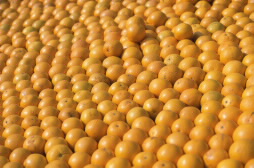FOR IMMEDIATE RELEASE | June 18, 2012
New ‘OPEC’ offers sustainable smell of sweet success
WASHINGTON, June 18, 2012 — The least appealing part of the world’s most popular citrus fruits could soon be more alluring to cosmetic and drug manufacturers and, perhaps, eventually help heat our homes and fuel our cars.
In research described today at the 16th annual Green Chemistry & Engineering Conference, scientists from the United Kingdom said they have developed a sustainable way to extract and find uses for virtually every bit of the 15.6 million tons of orange and other citrus peel discarded worldwide every year. These uses could include biosolvents, fragrances and water purification. The project, dubbed the Orange Peel Exploitation Company (OPEC), is a partnership between researchers from the University of York, University of Sao Paulo, Brazil, and the University of Cordoba, Spain. The research team hopes to have a prototype biorefinery up and running soon.
Media Contact
Joan Coyle
202-872-6229
j_coyle@acs.org
The conference (www.gcande.org) is sponsored by the American Chemical Society’s Green Chemistry Institute® (ACS GCI).
“This is a great example of what can be done with something that is produced in quantities that would astound people,” said James Clark, Ph.D., director of the University of York’s Green Chemistry Centre of Excellence. “At the moment, orange peel has very little value and actually can have a negative effect on the environment. We believe that using the biorefinery concept in combination with the principles of green chemistry will allow us to make a whole series of products that can displace traditional, often petrochemical-based, manufacturing processes.”
Brazil and the United States produce about 38 percent of the world’s oranges, Clark said. After juicing, peel represents about 50 percent of the orange’s mass, which until now has been usually discarded, either by burning, which creates greenhouse gases, or by dumping in landfills, where oils from the rotting peels can leach into the soil and harm plant life. In some cases, the largest juicing plants dry and detoxify orange peel so it can be used in livestock feed. Manufacturers also extract pectin, an ingredient used in foods, cosmetics and pharmaceuticals, from the peels. But these processes are time-consuming and costly and often require the use of acids and additional mechanical means.
Instead, Clark, Lucie Pfaltzgraff and colleagues said they have developed a green, one-step process that efficiently and simultaneously extracts compounds used in a variety of industries. The orange peels are exposed to high-intensity microwaves at low temperatures that transform many components of the orange peel into liquid that can be later collected and from which useful products are obtained. What remains is cellulose, which can be used as a food additive or a thickening agent or be converted into a solid biofuel.
“We’re aiming to create a zero-waste biorefinery,” Clark said. “We want to use everything. We want to give value to every component of the peel.”
The American Chemical Society is a nonprofit organization chartered by the U.S. Congress. With more than 164,000 members, ACS is the world’s largest scientific society and a global leader in providing access to chemistry-related research through its multiple databases, peer-reviewed journals and scientific conferences. Its main offices are in Washington, D.C., and Columbus, Ohio.
The ACS Green Chemistry Institute® is an organization focused on catalyzing and enabling the implementation of green chemistry and engineering throughout the global chemical enterprise. ACS GCI operates industrial roundtables; conducts conferences, seminars and training; maintains an international network of 26 green chemistry chapters; and with its partner NSF International, led the effort to establish the first consensus standard for greener chemical products and process information in the United States.
To automatically receive news releases from the American Chemical Society contact newsroom@acs.org.
###

chemical compounds from the nearly 16 million
tons of citrus peel waste produced worldwide
every year.

